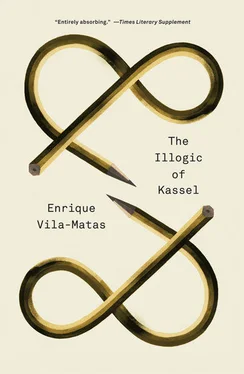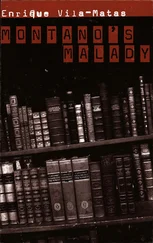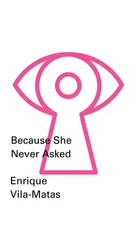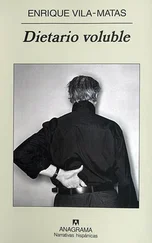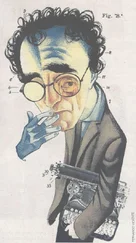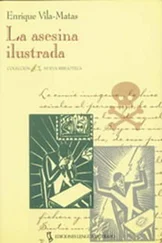We also saw the inverted, belowground reproduction (by the artist Horst Hoheisel) of the magnificent fountain financed by the Jewish businessman Sigmund Aschrott. The original had been erected in the middle of the city and was brutally demolished in 1939.
We took a long and agreeable turn around Karlsaue Park. The park was getting busier all the time — a lot of people were arriving at the last minute for Documenta’s final weekend, and it was increasingly packed. We decided to head into downtown Kassel, and there we bumped into Lara Sánchez, blogger for the Spanish newspaper, El País . She had just seen Fatigues , the very show by Tacita Dean we ourselves were going to.
Despite beginning to feel worn out and fearing for my appointment with Chus, not to mention my mental stability, we paid a visit to the outdated, ugly branch office of a bank, the least poetic place in the world. It was in this old financial center that Tacita Dean had left her wonderful drawings on large chalkboards, which were a very intense green color and reminded me of the extraordinarily vivid green from my dream in Sarzana: that chalkboard-green that suddenly turned into the green of a doorway fitting into a pointed Arabic arch, on which my friend Pitol was inscribing, slowing down the rhythm of his hand, the poetry of an unknown algebra.
Tacita Dean was the only participant in Documenta whose work I knew something about, because two years earlier I’d seen The Friar’s Doodle in Madrid, an exhibition centered on motifs she’d photographed that were engraved onto the colonnade at the cloister of the Abbey de Silos.
I’d been to see The Friar’s Doodle on Dominique González-Foerster’s recommendation and discovered an exhibition that interested me very much, focused on the strange traces of carvings a few unknown men had made in the stone of the pillars there over the centuries. Marks had been made by individual artisans in order to work out the price of their labor; there were rudimentary boards for playing games on, probably the work of stonemasons to amuse themselves while waiting for the newly carved columns to be set into the fabric of the building. There were also rough sketches of ornamental designs for the cloister.
While thinking about those carvings at Silos, I saw that a lot of people were forming a line to see Tacita Dean’s Afghan chalkboards. Once again, María Boston resorted to those passes that got us in fast. As the line was in a narrow passageway, everyone was keeping a strict eye on everyone else, and it didn’t seem okay to simply jump ahead of people who’d been waiting their turn for a couple of hours. I adopted a serious official demeanor, as if I were secretary to officer Boston on her routine inspection of the site.
I did everything I could to show secretarial nonchalance and convince them all that I belonged to Documenta’s imaginary board of supervisors, but of course all that was only my conjecture and what everyone saw was a young woman with a seductive voice and an old man both brazenly flourishing bits of paper and getting straight in without any trouble. The protests were loud and even caused me a certain amount of reasonable panic, as the passage was narrow. In addition, I was becoming increasingly sensitive, no doubt as a result of having slept so little.
But once inside the old and antipoetic bank building, all was well. Tacita Dean’s chalkboard murals had a blindingly green background and were an evocation of time suspended in the snowy Afghan mountains, although the truth is I was slow to realize that those perfect drawings — among the most elegant I’ve seen in my life — had been done in chalk in situ, in that very place with a long commercial history where, according to Boston, many artists had previously refused to show their work but which, on the contrary, Tacita Dean had liked from the outset.
The artist had spent several weeks in Kassel drawing that very lovely series of images for Fatigues , in which she depicted, with originality and great precision, the Hindu Kush mountains, and the glacial source of the Kabul River. The drawings showed the melting and annual descent of snow-water on the capital of Afghanistan, a phenomenon that seemed to be both welcomed and feared. But in that series, which Boston told me constituted Tacita Dean’s return to drawing on boards (she hadn’t touched chalks for ten years), the artist was also giving a nod toward Rudyard Kipling’s poem “Ford o’ Kabul River” (a moving piece about British soldiers who drowned in the second Anglo-Afghan War), as well as to the forces of nature and the Kabul River’s terrible power.
María Boston said Tacita Dean’s show was among the most visited at Documenta, which didn’t surprise me, given the sober and impeccable, classical elegance of the drawings. It did seem strange that in an exhibition of the avant-garde, the closest thing to what could be considered orthodox should make such an impression.
While we were walking around what used to be the offices of the old savings bank, we ran into Carolyn Christov-Bakargiev, the head commissioner or curator of Documenta and one of those people you see right away, as soon as you meet them, who need no kind of push, not even of the invisible sort; she was someone whose gaze seemed to carry a certain brilliance, and you could tell she enjoyed stirring things up verbally. She was accompanied by Chus’s assistant, Ada Ara, a woman from Zaragoza who lived in Berlin. Her name seemed made up or a pseudonym, all the more so if you knew that in Catalan ara means now .
“Ada Now,” I said. “That sounds like a stage name.”
No sooner had I let drop this remark — none too fortuitous, it goes without saying — than I blundered into what might be described as a brief and unfortunate loop of clumsiness. It all started when Carolyn asked me in English (which I understood perfectly) what I thought of Documenta. No doubt it was a routine question, but I wasn’t ready for the artistic director, the one responsible for the whole show — it’s always impressed me greatly to meet the person in charge — to ask me such a thing, and I became absurdly tongue-tied, as if the power of speech had been snatched from me.
“Carolyn’s asking how the work you’ve seen in Documenta has made you feel,” Ada Ara clarified for me.
“That. . well, um. . that there is no world.”
Ada Ara translated my answer with a smile that sought to minimize the possible contradiction in what I’d just said. Carolyn, giving me what seemed a look of disappointment, wanted to know what there was if, as I maintained, there was no world. It was one of the most challenging questions of the day, but at that moment an invisible impulse — or perhaps it was just nervousness due to my extreme fatigue — pushed my energy level up another notch, as if it wanted to come to my aid.
“There’s a corollary,” I said.
But asserting this — possibly a bad move, influenced by the excessive energy I sometimes suspected flowed from that invisible inner current — was even worse. I bowed my head, conscious that what I’d said didn’t make the grade as a McGuffin and also aware that I wasn’t even altogether sure why I’d expressed it that way. I never liked taking exams and I had the feeling I was taking one there in front of Carolyn; maybe that’s what had made me nervous and gotten me lost in the deranged muddle of my answers.
Ada Ara asked what a corollary was. It’s an outcome, a conclusion, Boston said. They amused themselves arguing over what a corollary was, and in the end Carolyn, getting impatient, asked me again what on earth there was if there wasn’t a world. There’s a conclusion, Boston said, speaking for me. Carolyn pierced me with a terrifying look that made everything infinitely more difficult. She seemed to be saying: But, really, is this the writer they recommended to me, the one they told me we should select? Then she asked me, What conclusion? I was paralyzed, utterly mute. None, I ended up saying. I saw Carolyn was very upset and angry. Suddenly, she let fly: “So what do we do now? Accept it all calmly, implode with panic, or what?”
Читать дальше
